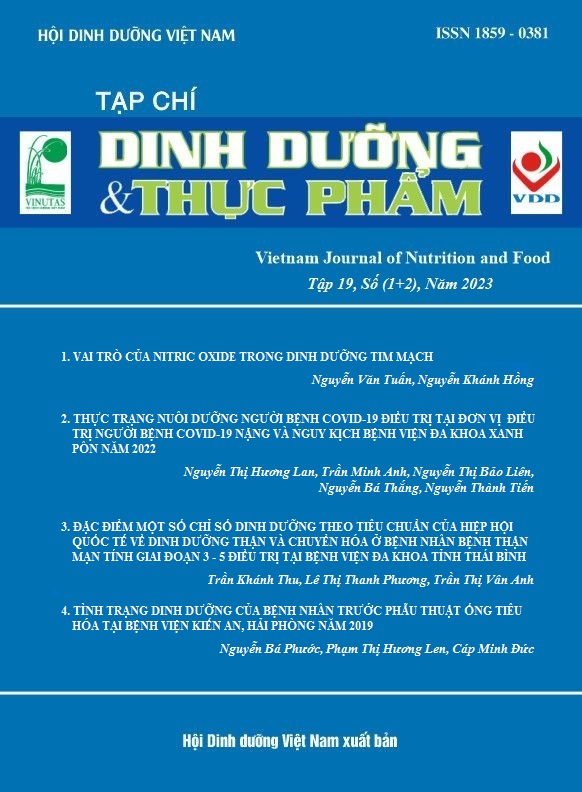ĐẶC ĐIỂM MỘT SỐ CHỈ SỐ DINH DƯỠNG THEO TIÊU CHUẨN CỦA HIỆP HỘI QUỐC TẾ VỀ DINH DƯỠNG THẬN VÀ CHUYỂN HÓA Ở BỆNH NHÂN BỆNH THẬN MẠN TÍNH GIAI ĐOẠN 3 - 5 ĐIỀU TRỊ TẠI BỆNH VIỆN ĐA KHOA TỈNH THÁI BÌNH
Nội dung chính của bài viết
Tóm tắt
Mục tiêu: Xác định tỷ lệ và đặc điểm một số chỉ số dinh dưỡng theo tiêu chuẩn của Hiệp hội Quốc tế về Dinh dưỡng thận và Chuyển hóa ở bệnh nhân bệnh thận mạn tính giai đoạn 3 - 5 điều trị tại Bệnh viện Đa khoa tỉnh Thái Bình.
Phương pháp: Nghiên cứu mô tả qua cuộc điều tra cắt ngang được thực hiện trên 130 bệnh nhân bệnh thận mạn tính giai đoạn 3-5. Hội chứng hao mòn protein-năng lượng (HCHMPN) được phân loại theo tiêu chuẩn của Hiệp hội Quốc tế về Dinh dưỡng thận và Chuyển hóa.
Kết quả: Tỷ lệ bệnh nhân có HCHMPN là 71,5%. Bệnh nhân có HCHMPN với biểu hiện từ 1 đến 4 tiêu chuẩn chính, trong đó đối tượng với 2 tiêu chuẩn gặp với tỷ lệ cao nhất (55,9%), với 4 tiêu chuẩn gặp với tỷ lệ thấp nhất (3,2%). Tỷ lệ HCHMPN giảm dần từ mức độ vừa đến nặng và nhẹ. Giảm BMI đáp ứng tiêu chuẩn chẩn đoán HCHMPN gặp với tỷ lệ cao nhất (61,5%); giảm protein máu toàn phần gặp với tỷ lệ thấp nhất (12,3%). Một số tiêu chuẩn phụ để chẩn đoán HCHMPN gặp với tỷ lệ khác nhau, trong đó giảm số lượng tế bào lympho: 52,3%; chán ăn: 40,8%; tăng triglycerid: 27,7%; giảm kali máu: 18,4%.
Kết luận: Bệnh nhân bệnh thận mạn tính giai đoạn 3-5 có tỷ lệ cao bị hội chứng hao mòn protein-năng lượng cần quan tâm đánh giá để có điều trị dinh dưỡng thíc hợp trong thực hành lâm sàng.
Từ khóa
Hội chứng suy mòn protein-năng lượng, suy thận mạn, Bệnh viện Đa khoa tỉnh Thái Bình
Chi tiết bài viết
Tài liệu tham khảo
2. Foque D, Kalantar-Zadeh K, Kopple J, Cano N, Chauvea P, Cuppari L, et al. A proposed nomenclature and diagnostic criteria for protein-energy wasting in acute and chronic kidney disease. Kidney Int. 2008;73(4):391–8.
3. 2.Obi Y, Qader H, Kovesdy CP, Kalantar-Zadeh K. Latest consensus and update on protein-energy wasting in chronic kidney disease. Curr Opin Clin Nutr Metab Care. 2015;18(3):254–62
4. Kovesdy C and Zadeh KK. Protein-energy wasting as a risk factor of morbidity and mortality in chronic kidney disease. Nutritional Management of Renal Disease. 2013; chapter 12, pp.171-195.
5. KDIGO. Definition and classification of CKD. Kidney International Supplements. 2013;3(1):19-62.
6. Iguacel CG and Parra EG. Defining protein-energy wasting syndrome in chronic kidney disease: prevalence and clinical implications. Nefrologia. 2014;34(4):507-519.
7. Phan Xuân Tước. Nghiên cứu một số chỉ số liên quan đến dinh dưỡng - năng lượng ở bệnh nhân lọc máu chu kỳ điều trị tại bệnh viện Nguyễn Trãi Thành Phố Hồ Chí Minh. Luận văn Bác sĩ Chuyên khoa II, Học viện Quân Y, 2017.
8. Foucan L, Meralult H, Line F, et al. (2015). Impact of protein energy wasting status on survival among Afro-Caribean hemodialysis patients: a 3 years prospective study. Springer Plus. 2015;4:452.
9. Larumbe MCT, Soto CC, Sagrado MG, et al. Sun-116: prevalence and severity of protein energy wasting (PEW) syndrome in maintenance hemodialysis patients. Evaluation of diagnostic criteria. Clinical Nutrition. 2016;35(1):s87.
Các bài báo tương tự
- Hoàng Khắc Tuấn Anh, Trần Thị Vân Anh, Phạm Thị Dung, Lê Đức Cường, TÌNH TRẠNG DINH DƯỠNG Ở BỆNH NHÂN LAO ĐIỀU TRỊ TẠI BỆNH VIỆN PHỔI THÁI BÌNH NĂM 2017 , Tạp chí Dinh dưỡng và Thực phẩm: Tập 14 Số 4 (2018)
Ông/Bà cũng có thể bắt đầu một tìm kiếm tương tự nâng cao cho bài báo này.


